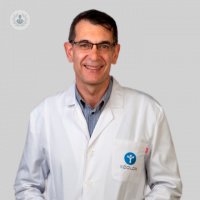Guide medullary neurostimulation
Written by:Medial or posterior cords neurostimulation is a minimally invasive technique for the control of chronic pain that was introduced by Shealy in 1967. Currently, about 50,000 neurostimulators are implanted every year around the world for the treatment of different pathologies.
Technique
Medullary neuro-stimulation consists of the following components: 1 or 2 electrodes , an extension cord, a pulse generator and an external programmer. The electrodes may have 4 to 8 poles and are placed in the epidural space in number of one or two. They are usually introduced through the skin using local anesthesia and sedation as it is the least invasive procedure. The electrodes advance through the epidural space until they are located in a region of the spinal cord that picks up the sensitivity of the patient's pain area. Electrical impulses are sent, the patient then notices a painful, non-painful stimulus that covers the area affected by the pain and seeks to "plug" or block painful impulses.
This procedure is called the first time since the electrodes are left in that area and a temporary cable connected to an external generator is connected to an external generator. The parameters of frequency, amplitude and intensity of the electrical impulses are programmed and the patient is instructed in the use, on and off of the system. It is a provisional period of one or two weeks after which if the patient has noticed a decrease of their pain of 50% or higher, together with an improvement in their quality of life is considered to respond to the treatment and a definitive generator is placed below of the skin.
Mechanism of action
There are different theories to explain the analgesia produced by spinal neurostimulation. One of them is the theory of the door of entry of the pain, proposed by Melzack and Wall in 1965. Painful impulses from an area of the body are transmitted through the nerve pathways to the spinal cord and from this to the brain that makes us aware of that pain. Through electrical impulses that travel faster than pain, it can block its entry into the marrow and mitigate the painful sensation. Also the spinal cord neurostimulation causes dilation of the capillaries (very small blood vessels), causing more blood to reach the stimulated areas.
Indications
Where more has been applied spinal neurostimulation is in the so-called " back surgery failure syndrome ", ie those patients operated on one or more times in the spinal column for herniated discs and who have not been able to get relief from their low back pain or Leg. It is also applied in pains secondary to nerve injury, such as in cases of postherpetic neuralgia, peripheral neuropathies, occipital neuralgia, reflex sympathetic dystrophy. In cases of obstruction of the arteries that produce ischemia of the extremities in those patients who are not subsidiary of more surgical interventions and in special cases of myocardial angina.
Complications
It is a relatively safe process. The most common complication is that the electrodes move from the appropriate site and have to be replaced. Another complication is surgical wound infection, but this is very rare with correct aseptic measurements.
Cost and effectiveness
In the observations made in patients with previous surgery in the spine, it has been observed that the initial cost is important, but if adequate pain relief is achieved it is an alternative to a new operation. In addition, the use of analgesics, visits to the specialist or the use of medical resources such as rehabilitation will be diminished in the long run.
conclusion
Medullary stimulation has demonstrated in methodologically correct investigations a satisfactory clinical efficacy. It is postulated as an alternative to consider in cases of patients with chronic pain difficult to alleviate, who do not respond to pharmacological or rehabilitative treatments .



